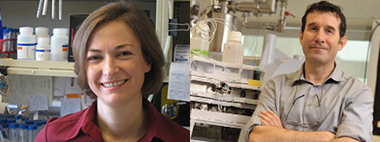Flagging Viral Threats
.png) |
|
A representation of the hepatitis C virus. |
 |
|
Cara Pager and Daniele Fabris |
ALBANY, N.Y. (Feb. 27, 2019) — Two UAlbany RNA researchers are drawing us closer to realizing the magnitude of RNA’s role in harmful and sometimes deadly viruses.
Assistant Professor Cara Pager of Biological Sciences and Professor Daniele Fabris of Chemistry — both faculty of The RNA Institute — were recently awarded a $1.9 million National Institutes of Health (NIH) grant to study how adding different chemical groups on RNA affects the infectious cycle of a virus.
Research supported by the grant will build upon the established findings of the two researchers that RNA in cells and RNA isolated from different viruses such as HIV-1, hepatitis C, Zika, Dengue and polioviruses, are coated with chemical groups. When the chemical groups are added onto RNA, the original characteristic and shape of the RNA changes, which can give the RNA a completely new function.
“This project will transform our view of the genetic material of RNA viruses, from a simple string of letters or nucleotides that is used to make viral proteins and new viral genetic material, to master regulators of the infectious cycle,” said Pager.
The researchers will study how viruses manipulate the host cell into “decorating” the viral RNA with chemical groups and whether, during infection, these chemical marks help camouflage the virus or flag it as an invader. “I think of these chemical marks on the viral RNA as communication flags to signal danger, or to instruct the cell to take action” said Pager.
Beyond the virology field, the knowledge generated by this research will help to clarify how chemical groups on RNA impact gene regulation — a finding highly anticipated by the scientific community but, to date, not achieved.
This knowledge will shed new light onto the functions of the epitranscriptome (the biochemical modifications of the RNA within a cell) in many other processes involving RNA, and this will help expand the understanding of devastating diseases linked to RNA malfunction.
“I am thrilled that the hard work by two RNA Institute members has been recognized by the NIH, and I look forward to the exciting results from the collaborative efforts of the Fabris and Pager labs,” said Andy Berglund, director of the RNA Institute and SUNY Empire Professor of Innovation in the Department of Biological Sciences
“It’s very exciting to anticipate the outcome of the interdisciplinary science between Dr. Pager, a virologist, and Dr. Fabris, an expert on RNA modifications,” said Marlene Belfort, Distinguished Professor of Biological Sciences. “One can imagine learning how these modified RNAs regulate the viral life cycle in interesting ways.”
![]() For more news, subscribe to UAlbany's RSS headline feeds
For more news, subscribe to UAlbany's RSS headline feeds
A comprehensive public research university, the University at Albany-SUNY offers more than 120 undergraduate majors and minors and 125 master's, doctoral and graduate certificate programs. UAlbany is a leader among all New York State colleges and universities in such diverse fields as atmospheric and environmental sciences, business, education, public health,health sciences, criminal justice, emergency preparedness, engineering and applied sciences, informatics, public administration, social welfare and sociology, taught by an extensive roster of faculty experts. It also offers expanded academic and research opportunities for students through an affiliation with Albany Law School. With a curriculum enhanced by 600 study-abroad opportunities, UAlbany launches great careers.


